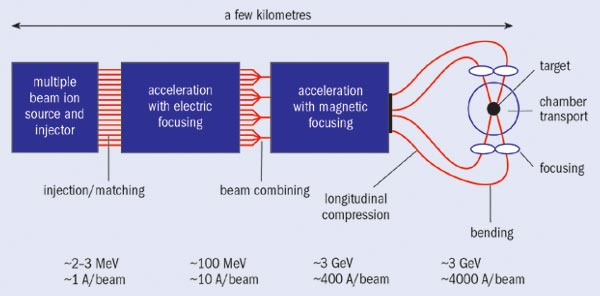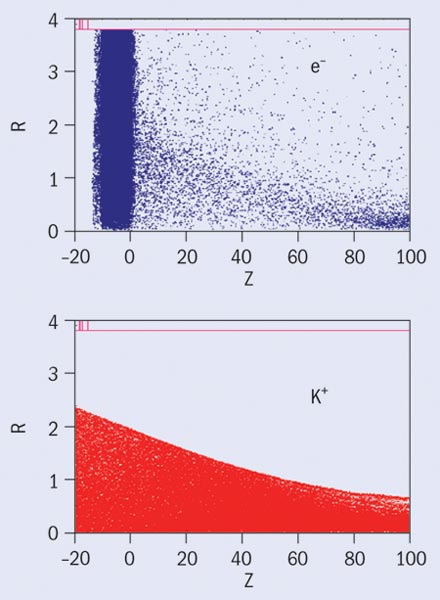Three US laboratories have teamed up to form the Heavy-Ion Fusion Virtual National Laboratory to investigate a novel approach to fusion energy. Christine Celata profiles the highly tangible programme of the fledgling virtual lab.

In the mid-1970s Al Maschke of the US Brookhaven National Laboratory suggested that heavy-ion beams, rather than laser beams, could be used as a driver to implode inertial-fusion targets for the commercial generation of electrical power. The beams would deliver the kinetic energy that would heat the surface of a capsule containing deuterium and tritium, with the resulting ablation driving a compression that causes nuclear fusion. Heavy ions have the advantage that energy deposition is simpler with them than with photons, while much of the accelerator technology necessary has already been demonstrated to have long life, a sufficiently high pulse repetition rate and high electrical efficiency.
In the US, researchers from three laboratories – Lawrence Berkeley National Laboratory (LBNL), Lawrence Livermore National Laboratory (LLNL) and Princeton Plasma Physics Laboratory (PPPL) – have formed the US Heavy-Ion Fusion Virtual National Laboratory (HIF-VNL) to coordinate their work on heavy-ion fusion.
Heavy-ion fusion research is carried out in several laboratories around the world. As well as the HIF-VNL in the US, a high-space-charge electron ring at the University of Maryland will study intense beam physics. Researchers from the Naval Research Laboratory, the Mission Research Corporation, the University of Michigan, the Massachusetts Institute of Technology, the Sandia National Laboratory and the Stanford Linear Accelerator Center are also involved in the US heavy-ion fusion programme. Other efforts aimed at both accelerator physics and studying the interaction of heavy ions with hot matter exist at GSI in Germany; the Tokyo Institute of Technology, RIKEN, Utsunomiya University and Osaka’s Institute of Laser Engineering in Japan; Orsay in France; and the Russian Institute for Theoretical and Experimental Physics. This article describes the progress and plans of the HIF-VNL programme.
Induction linac drivers
For its driver accelerator the US programme has chosen an induction linac – a linear accelerator that accelerates ions by changing the strength of a magnetic field in magnetic material encircling the beams. The induction cores of such linacs have high efficiency at the high beam currents that fusion demands, and their cost is relatively low. Moreover, electrical losses in induction cores remain effectively constant as the beam current increases, while more and more energy goes into the beam, since essentially the same electric accelerating field is produced. And because linacs are one-pass machines, they are able to stably transport the extremely intense beams that are necessary to implode the target; around 1-7 MJ must be deposited in approximately 10 ns, corresponding to around 1016 ions of mass 200 amu at 3 GeV.
Quadrupole focusing field limits make it very uneconomical to transport such a large amount of charge in a single beam. The approach being followed is therefore to transport multiple (100-200) beams in parallel through a common set of induction cores that would encircle the beam array. Beams from a multiple-beam injector would enter the linac at an energy of about 2 MeV. They would then be accelerated over a few kilometres to a few GeV. Electrostatic quadrupoles would be used for focusing up to about 100 MeV in some designs (figure 1); thereafter focusing would be done by arrays of superconducting quadrupoles.
At the end of the accelerator a coherent “velocity tilt” would be applied, accelerating the tail of the beam more than the head to produce longitudinal compression of a factor of 10-20, shortening the pulse to around10 ns. The beams would then go through a final focusing system, and transport through the target chamber to the target. The pulse repetition rate would be about 5 Hz, with clearing of the chamber of target debris, molten salt, and gas being the limiting factor. The challenge is to maintain very low emittance, both transverse and longitudinal, in the presence of the beams’ high space charge, so that the beams will focus to a spot a few millimetres across at the end of the driver.
Beam dynamics in this accelerator are determined largely by space charge – the space-charge depression of the betatron phase advance per lattice period is approximately a factor of 10, so that space charge nearly cancels out external focusing forces. The beams act like non-neutral plasmas, exhibiting normal modes and instabilities not found in single-particle dynamics. Therefore self-consistent particle-in-cell (PIC) time-domain simulations are the main tools used to calculate beam behaviour. In the target chamber the problem is complicated by the need to shield the chamber walls from neutrons, radiation and target debris. Designs include sheets and crossed jets of the neutron-thick molten salt FLiBe (a salt of fluorine, lithium and beryllium) in the target chamber, shielding the walls from these target products. Beams pass through spaces between the jets. FLiBe vapour can then neutralize the beam, helping focusing, but will also strip beam ions, and under some conditions can lead to plasma instabilities. Photoionization of the salt also provides a copious source of electrons near the target after ignition. Modelling in the target chamber therefore requires multispecies, 3D, time-dependent electromagnetic simulation with fully self-consistent space charge.
Experiments at LBNL in the 1980s and 1990s showed that space-charge-dominated beams are stable, and can be accelerated and compressed in an induction accelerator, combined and focused to a spot. A quarter-turn experiment at LLNL demonstrated the bending of an intense beam. These were scaled experiments at up to 1 MeV, with currents of a few tens of milliamps or less. Dimensionless physics parameters were designed to be in the same range as in a driver, so that physics tests were valid. The HIF-VNL programme is now moving to experiments with currents similar to those of a driver beam at low energy (0.1-1 A), so that effects dependent on the beam’s electrostatic potential can be studied. The programme currently focuses on three experimental thrusts: the High Current Experiment (HCX); a Neutralized Transport Experiment (NTX); and experiments exploring a new “minibeamlet” injector concept.
New experiments

The HCX at LBNL saw its first beam in January and is in the process of commissioning. Its main mission is to investigate the optimum aperture for transporting an intense high-current beam. Since induction cores must encircle the whole array of beams in a driver, the selection of the transverse aperture allotted to each beam can significantly affect driver cost, and therefore design optimization. The HCX programme will investigate the influence on beam propagation and brightness of a range of physics – image forces, mismatch of the beam envelope to the focusing system (which through a resonance can pump ions into a halo), and gas and electrons produced by scraping halo. The HCX is a single-beam experiment, using a drifting 0.2-0.5 A, 1.0-1.8 MeV beam of K+ ions. Since the beam potential is about 2 kV, beam space charge has a strong effect on electron orbits.
The experiment currently consists of an injector followed by 10 electrostatic quadrupoles. At least four magnetic quadrupoles will be added to study the production and orbits of electrons produced intentionally by beam scraping. Next year up to 30 more quadrupoles will be added to continue the dynamic aperture studies. Finally a small induction core will be used to explore the longitudinal confinement of the beam by tailoring the induction pulse.

Princeton is making a plasma source for the NTX, which is currently at the design stage and will also be at LBNL. Starting in 2003, it will investigate beam physics in the final focus system along with intentional neutralization of the beam after the final lenses. The NTX will consist of a 400 keV injector followed by a four-quadrupole focusing system. A plasma source downstream will study various neutralization methods that could counteract the space charge of the beam, producing a smaller spot at the target. The effects of both a small plasma source upstream of the target chamber and bulk plasma in the target chamber – as would be produced by photoionization of FLiBe – will be investigated. Another important area of interest for the NTX is the correction of aberrations in the final lens system. This is a well known problem for beams with negligible space charge, but the effects of space charge in the HIF case are significant and the prescription for aberration correction is not well understood.
A new concept for an intense beam injector is in the design stage, with an experimental test planned for 2004. The Child-Langmuir law shows that, because voltage limits increase only as (approximately) the square root of the voltage for a large diode, the current density of the beam increases as the current and radius of the beam decrease. Therefore it is theoretically possible to make the injector more compact – a very important feature for a multibeam accelerator – by making each of the accelerated beams with small, very bright beamlets, which merge later in the injector to form a single beam. Arranging the beamlets to match parameters for the downstream lattice can also eliminate the transverse blow-up of the beam in the matching section. The experiment will merge around 100 high-current-density beamlets of 12 mm radius near the end of the injector to make a single 0.5 A, 1.6 MeV heavy-ion beam. 3D PIC simulations project the emittance to be similar to that of beams from a standard large diode. The beamlet-merging idea has already been used in neutral-beam-heating accelerators for tokamaks, but in that case protons were used and emittance was not important.
Once the experiments are completed, the programme will be ready for a source-to-target experiment that integrates all the beam manipulations needed in a driver. A workshop held in October 2001 chose the overall design parameters for an Integrated Beam Experiment (IBX). The IBX is envisioned as a single-beam experiment, possibly upgradable to more beams, with final energy in the 10-20 MeV range. It will incorporate almost all of the physics of the driver (and much engineering at full scale), the exceptions being in the areas of beam-target physics, multiple-beam interactions and high-energy effects such as self-magnetic and inductive effects. In particular, the experiment will be able to study longitudinal beam dynamics, including wave motion on the beam, halo formation and beam heating over intermediate transport lengths, the bending of space-charge-dominated beams, and self-consistent final drift compression, final focus and neutralization.
Looking ahead, the HIF-VNL envisions an Integrated Research Experiment of a few hundred MeV that carries arrays of multiple beams all the way to the target and is capable of beam-target studies. All this is taking the accelerator aspects of heavy-ion fusion research in the US from exploration of the concept through to proof of principle.





